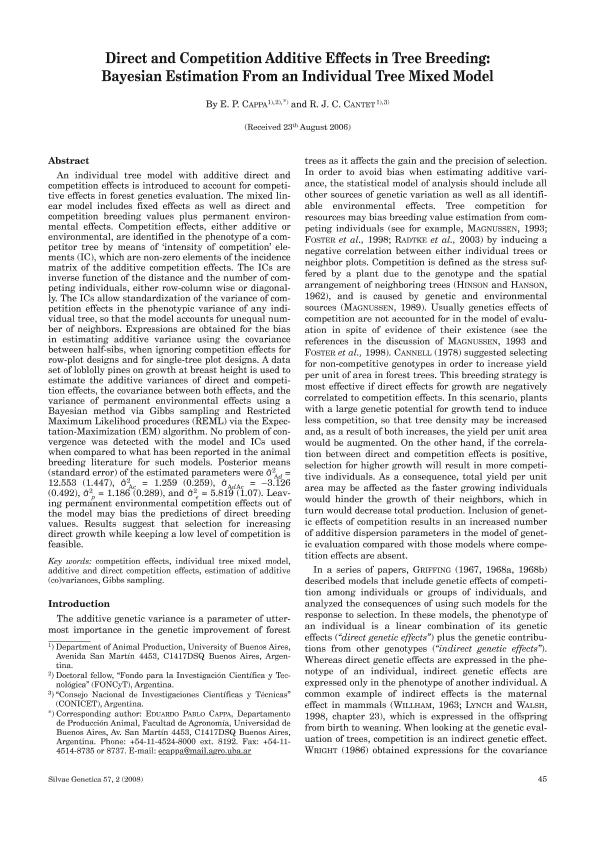Artículo
Direct and Competition Additive Effects in Tree Breeding: Bayesian Estimation From an Individual Tree Mixed Model
Fecha de publicación:
12/2008
Editorial:
J D Sauerlanders Verlag
Revista:
Silvae Genetica
ISSN:
2509-8934
Idioma:
Inglés
Tipo de recurso:
Artículo publicado
Clasificación temática:
Resumen
An individual tree model with additive direct and competition effects is introduced to account for competitive effects in forest genetics evaluation. The mixed linear model includes fixed effects as well as direct and competition breeding values plus permanent environmental effects. Competition effects, either additive or environmental, are identified in the phenotype of a competitor tree by means of ‘intensity of competition’ elements (IC), which are non-zero elements of the incidence matrix of the additive competition effects. The ICs are inverse function of the distance and the number of competing individuals, either row-column wise or diagonally. The ICs allow standardization of the variance of competition effects in the phenotypic variance of any individual tree, so that the model accounts for unequal number of neighbors. Expressions are obtained for the bias in estimating additive variance using the covariance between half-sibs, when ignoring competition effects for row-plot designs and for single-tree plot designs. A data set of loblolly pines on growth at breast height is used to estimate the additive variances of direct and competition effects, the covariance between both effects, and the variance of permanent environmental effects using a Bayesian method via Gibbs sampling and Restricted Maximum Likelihood procedures (REML) via the Expectation-Maximization (EM) algorithm. No problem of convergence was detected with the model and ICs used when compared to what has been reported in the animal breeding literature for such models. Posterior means (standard error) of the estimated parameters were σˆ 2 Ad = 12.553 (1.447), σˆ 2 Ac = 1.259 (0.259), σˆ AdAc = –3.126 (0.492), σˆ 2 p = 1.186 (0.289), and σˆ 2 e = 5.819 (1.07). Leaving permanent environmental competition effects out of the model may bias the predictions of direct breeding values. Results suggest that selection for increasing direct growth while keeping a low level of competition is feasible.
Archivos asociados
Licencia
Identificadores
Colecciones
Articulos(OCA PQUE. CENTENARIO)
Articulos de OFICINA DE COORDINACION ADMINISTRATIVA PQUE. CENTENARIO
Articulos de OFICINA DE COORDINACION ADMINISTRATIVA PQUE. CENTENARIO
Citación
Cappa, Eduardo Pablo; Cantet, Rodolfo Juan Carlos; Direct and Competition Additive Effects in Tree Breeding: Bayesian Estimation From an Individual Tree Mixed Model; J D Sauerlanders Verlag; Silvae Genetica; 57; 1-6; 12-2008; 45-56
Compartir
Altmétricas




